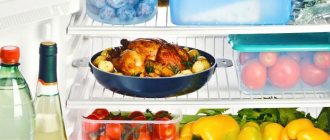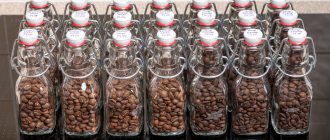Many housewives prefer to store vegetables and fruits in the refrigerator without even thinking about the fact that in it they can lose their wonderful aroma, pleasant taste and nutrients beneficial to the human body. Most often this happens because we do not store vegetables in the refrigerator correctly.
For this reason, they become severely overcooled and become inedible. The ideal place to store absolutely all fruits is the so-called zero zone. In this place, vegetables and fruits can be stored for quite a long time without any problems.
But unfortunately, there is not always enough space for all the fortified products and we have to put them on other shelves. But in order for them to remain tasty and aromatic here, it is necessary to adhere to certain storage rules and pay attention to the product vicinity.
How and for how long should horseradish root be stored in the refrigerator, peeled and for the winter?
Optimal ways to store horseradish
- Horseradish, despite its dense structure, is stored very poorly. The fact is that as soon as you take it out of the soil, it literally immediately begins to lose moisture. And the more it goes away, the less spicy and piquant its taste becomes. Therefore, if you want to extend the life of this root vegetable at least a little, then store it in the refrigerator. But before you put it there, you must carry out proper preparation.
- Horseradish must be cleared of soil, rinsed under running water, and then placed on a paper towel and allowed to dry naturally. After this, each root must be individually wrapped in cling film and a couple of holes must be made in such packaging for ventilation. But I would like to immediately say that this storage method will extend the life of horseradish by literally 6-8 weeks.
- So if you want to use it for cooking for a longer period of time, then peel it, grind it in a food processor, put it in a container and put it in the freezer. There it will quietly stay until the next season, without losing even a small part of its beneficial properties.
General rules on how best to store fruit at home
Now we know which vegetables and fruits are stored in the refrigerator, and which ones can do without it. But if you know some tricks, you can preserve freshness and taste for a long time:
- Vegetables and fruits should not be stored together. The fact is that the fruits themselves emit harmful ethylene, which can cause vegetables to spoil.
- Moldy fruits must be removed immediately to prevent the mold from spreading.
- If the fruits are not ripe, it is better to leave them at room temperature. Especially if they are peaches, pears, plums, persimmons, mangoes and kiwis. It is better to put ripe fruits in the refrigerator.
- Do not store fruit in a crowded refrigerator compartment. Air must circulate.
- It is advisable to store unwashed fruits in the refrigerator in their original packaging.
Knowing where and how to store fruits and vegetables, you can preserve not only the taste, but also the beneficial qualities of the products for a long time. And healthy food, as you know, is the key to health.
How and how long to store ginger in the refrigerator?
Store ginger in a separate bag.
Ginger is a very healthy and versatile product. You can use it to treat colds or add it to drinks, salads, desserts and sauces. But due to the fact that it has a very juicy structure, it can be stored in the refrigerator for no more than three weeks. After this period, visually it may still remain normal, but it will begin to lose its taste and aroma more and more every day.
It is best to store it on the vegetable shelf and preferably in a separate bag. Ginger, like horseradish, should be wrapped in a paper napkin and, in this form, placed in a vacuum bag. Yes, and pack it this way, in small portions at once. If you take it out and cut it several times a day, this will reduce its shelf life by about half.
What is important to consider
First, a little chemistry lesson.
Ethylene is an odorless and colorless gas that helps some fruits ripen. Some fruits contain a lot of it (for example, apples and pears), and some have negligible amounts. Fruits containing large amounts of ethylene:
- apples,
- apricots,
- avocado,
- bananas,
- melons,
- figs,
- nectarine,
- peaches,
- pears,
- plums,
- tomatoes.
They should not be stored with other fruits and vegetables. Unless you want them to finish it faster.
For example, if you put a banana in a paper bag, it will ripen faster because the ethylene will be trapped in the paper. Or you can put an apple or pear along with a banana.
It is also worth considering the fact that ethylene comes out faster from damaged fruit. As a result, one cracked apple can cause the entire package to spoil faster than usual.
Is it possible and how can I store peeled potatoes in the refrigerator for the winter?
Storing potatoes in the refrigerator
- Peeled potatoes have one unpleasant feature: literally within an hour after you remove the peel from them, they will begin to oxidize and darken, and even cold air cannot stop this process. Therefore, if you want potatoes to retain their beneficial properties, then immediately after you peel them, immerse them in water.
- This is how you can store it in the refrigerator for 2 to 3 days. But the vegetable will remain normal during this time only if you change the water in the container in which it lies at least twice a day. If you do not do this, then the starch that is in the root vegetable will be released into the water and fermentation will begin in it. Literally a couple of hours after the start of this process, the potatoes will become covered with mucus and become inedible.
- When storing peeled potatoes, one more feature must also be taken into account. The longer it sits in water, the harder and more watery its structure becomes. Therefore, if you plan to make puree from it in the future, it will be better if it is in the water for no more than 12 hours. Unpeeled potatoes can be stored in the refrigerator for 2 to 5 months.
Is it possible and how to store peeled garlic in the refrigerator for the winter?
It is best to pour peeled garlic with sunflower oil.
- Garlic, like any other vegetable, does not really like heat. If you just leave it lying around in the kitchen, the appearance of the vegetable will very quickly become unattractive. Therefore, it will be better if you store garlic in the refrigerator, especially since for this you do not need to look for some special place and choose neighbors on the shelf.
- If you put it in a glass jar and sprinkle it with ordinary flour, then in this form it can lie almost until next spring. The best option for storing peeled garlic is ordinary vegetable oil. If you put the peeled cloves in a container or jar with an airtight lid and fill them with oil, you can use them for food for quite a long time.
- If you feel sorry for transferring the oil, then you can take any bowl, put the aromatic cloves on it and sprinkle them on top with a thick layer of table salt. Although this method is less effective than the previous one, it will also extend the life of your garlic for some time.
How and how long to store radishes in the refrigerator?
Storing radishes in the refrigerator
- There are several ways to store radishes in the refrigerator. If you need it to sit for no more than a week, then simply rinse it in clean water, let the excess liquid drain a little, and then put it in neat rows in a glass jar and cover everything with a plastic lid. Be sure to keep in mind that with this storage method, there should still be a little water in the jar.
- Therefore, if you put completely dry radishes into a container, be sure to pour a couple of tablespoons of clean liquid into it. If desired, the jar can be replaced with a plastic bag, but you will definitely need to make a couple of holes in it for ventilation. If you want to eat this healthy product all winter, then give it a place at the very bottom of the refrigerator.
- Place the radishes in a special box for vegetables and fruits and cover them with damp sand. It should be laid in rows, lightly compacting each layer. Only late varieties of radishes are suitable for this storage method.
How to store
Every housewife is faced with the question: how to choose the right storage conditions for vegetables and at what temperature and how long to keep them so as not to spoil the harvest?
I will try to answer it, giving examples of the most common types of fruits.
Tomatoes
These vegetables have a thin skin and are almost 90% water, so for long-term storage you should strictly follow the recommendations: do not wash the fruits before storing and keep them at room temperature. If desired, tomatoes can be frozen, but in order for their taste not to be affected, it is necessary to strictly follow certain rules for preparing the fruit, which we described in detail on our website - see the article “How to store tomatoes.”
We recommend: Storing children's toys: how to organize chaos
Onion
If we are talking about young onions, then they should be stored in the refrigerator, wrapped in soft paper in advance to avoid rotting.
Mature bulbs, on the contrary, are best kept in special boxes that do not interfere with air circulation at room temperature. I often hang a whole “braid” of onions right in the kitchen so that I always have them at hand.
Eggplant
Eggplants are not intended for long-term storage. Even in the refrigerator, they should not be kept for more than 3-6 days, as they begin to deteriorate. They retain their taste and beneficial properties best in a cool place, away from sunlight.
Asparagus
It is preferable to eat this delicate vegetable fresh in order to get the maximum nutrients from it. If you can't cook it right away, wrap the asparagus spears in damp paper towels or a thin natural cloth before placing them in the refrigerator compartment.
Potato
Potatoes are the root crop that is most often subject to long-term storage, and there are many recommendations for this, which you can learn about from the material on our website - read the article “How to store potatoes.” The basic rule is to keep potatoes in a cool, dry, well-ventilated place and away from sunlight, which can cause the tubers to green or sprout.
Carrot
Storing fresh carrots involves little hassle. It feels perfect in the refrigerator compartment for vegetables and fruits and can stay there for several weeks, remaining crisp and full of vitamins. The main thing is to ensure access of oxygen to this root vegetable, which means you should avoid storing it in closed plastic bags or containers. Remember also that you should wash and peel off the top layer only before direct use for food.
White cabbage, cauliflower and Brussels sprouts, broccoli
These vegetables can be stored for a relatively long time (from one to two weeks) without changing their taste. The main thing is to keep them in a cool place, for example, in a special compartment of the refrigerator, avoiding exposure to moisture, which provokes mold and rotting.
Corn
Fresh corn on the cob can be stored either simply in a cool place or in a separate compartment of the refrigerator. There is not much water in them, so they can sit for several weeks. However, I advise you to eat the cobs quickly, because over time they begin to dry out, lose their taste and become tougher.
Celery
Celery can be kept in the refrigerator for up to a week - it tolerates storage in a cool place quite well.
cucumbers
Cucumbers like to be cool and dry, but begin to spoil relatively quickly. Therefore, it is best to keep fresh fruits for no longer than a week in a special compartment of the freezer. If you want to learn more about the secrets of their long-term storage, you can read the article on storing cucumbers published on our website.
We recommend: How to properly store prunes: proven methods
Zucchini
Zucchini and zucchini are similar to cucumbers in terms of basic storage rules. They also like to be cool and free of excess moisture and should not be kept in the refrigerator for more than one week.
Garlic
Garlic, like onions, prefers to be kept in dry, ventilated boxes where there is no direct sunlight. If you follow these simple instructions, you can store garlic bulbs all winter.
Lettuce and other greens
Lettuce and greens are perhaps the most tender representatives of vegetables. They must be stored in the refrigerator in a specially designed compartment. If the salad is in a bag, then it needs to be opened and air circulated. Before use, the leaves can be placed in a container of clean, cool water so that they are saturated with moisture. In addition, on our website you can find a detailed article on how to store greens.
Bell pepper
This vegetable can be stored in the refrigerator for about a week. It should be washed only before cooking.
Mushrooms
It is recommended to clean, cook or dry fresh mushrooms immediately after you buy them or bring them from the forest. In a pinch, they can be stored for a couple of days in a cool, dark place.
How and how long to store fresh cucumbers in the refrigerator?
Storing cucumbers in the refrigerator
- Since cucumbers are almost 90% water, during storage it is extremely important to ensure that it evaporates as little as possible or to allow the vegetables to receive the missing liquid from the outside. To do this, just pour a little water into a deep container and place the cucumbers in it, tails down.
- Try to install them tightly (only the butt of the vegetable should be in the water), but make sure that they do not cut into the edges of the container or pan. If you damage their thin skin, the cucumbers will still lose moisture and wither. This storage method will extend the shelf life of greens by literally 7-10 days.
- If you want the cucumbers to stay in the refrigerator for at least another week, then brush their peels with fresh white, dry them thoroughly and put them in the refrigerator in this form. When the protein dries, it will create a protective film that will prevent moisture evaporation and prevent oxygen from having a detrimental effect on the vegetable.
How to store fruit
Fruits are perishable products and the storage conditions for each type are individual. A refrigerator will help extend the “life” of apples, oranges, pineapples and grapes.
Fruits are highly perishable foods
But not all fruits tolerate low temperatures. For example, banana and lemon “prefer” warm, dry places. Peaches, plums and apricots will not last even 2 days at room temperature.
Apples
The shelf life of apples depends on the variety, harvest method and storage method.
You can extend the life of fruit in 3 ways:
- Easy installation. Apples are placed in a cardboard box or wooden box in 2-3 layers. The rows do not overlap with each other. The only condition is that the fruits are placed in containers with the stalks facing up. With this method of laying, apples are stored for 2-3 months.
- Laying with paper. Each fruit is individually wrapped in newspaper and laid out in layers in a wooden box with the stalks facing up. With this method, it is possible to preserve the integrity and taste of apples for 4-5 months.
- Laying with overflow. The bottom of the container is covered with a layer of sand, ash or sawdust. The apples are laid out in layers, sprinkling each row with filler. With this method of laying, the freshness of the fruit is preserved for up to 6 months.
You should not use a bag as a container for storing apples. Cellophane does not allow air to circulate and the fruits spoil faster.
Berries
It will not be possible to preserve the berries for a long time. This is a perishable product that can “live” in the refrigerator for a maximum of 2 days.
Advice - do not wash the fruits in advance. Water is harmful to them. To get rid of excess moisture, berries should be stored in a container on a paper pad.
Tropical fruits
Exotic fruits require special care.
Exotic fruits require special care
You can increase their shelf life by following a number of rules:
- Tropical fruits should not be kept in the refrigerator or in a room with a temperature below 10 degrees;
- they should be stored in perforated paper;
- Bananas must be kept separate from other fruits.
Fruits should be stored in poorly ventilated areas, as they quickly lose moisture.
How and for how long to store tomatoes in the refrigerator?
Storing tomatoes in the refrigerator
- I would like to say right away that tomatoes do not tolerate low temperatures quite well, so they should be stored in the refrigerator only as a last resort. And they must be placed there fully ripe. If you put a completely green tomato in the refrigerator, then due to lack of heat it simply will not be able to ripen and in the end you will still have to throw it away.
- It is best to store tomatoes in a fresh zone, where the temperature is always approximately the same. You need to put them in a container for vegetables literally in two rows. If you plant a lot of them, it is likely that the lower fruits will become crushed and begin to rot while lying for a long time.
- And if you use an old model of refrigerator, then additionally put newspaper or a cotton towel in the drawer with the tomatoes. They will be able to absorb excess moisture, which in turn will prevent the proliferation of putrefactive microflora.
How to store vegetables
Potato
Never use the refrigerator to store potatoes, otherwise the starch in them will turn into sugar, and the vegetable itself will acquire a sweet taste.
Use a brush to remove any remaining soil from the fruits and place them in a cool, dark place where the temperature remains at 4-5°C. It is best to store potatoes in the basement, out of reach of light, using plastic boxes lined with a layer of damp sand. Unlike other vegetables, potatoes require a little more heat, so containers with them should be placed at a higher level.
Do not store apples in the same container, as the fruit emits ethylene gas, which accelerates the process of potato spoilage.
Garlic and onion
Neither garlic nor onions (not shallots) should ever be stored in the refrigerator. They require a cool, dry place with good ventilation and a temperature of 5-8°C. Mesh bags in which a batch of vegetables is delivered to the store are ideal (they “breathe” perfectly). If you don't have a special bag, use a regular bowl. Place the garlic in it and store it in the pantry. You can also use a bag, just make sure it has enough ventilation holes.
A couple of interesting facts to note:
- potatoes release moisture, which accelerates the rotting of onions, so do not store them nearby;
- Green onions and shallots can be kept in the refrigerator;
- Garlic can be used to make garlic powder, which makes an excellent seasoning.
Want to stop crying when cutting onions? Cool it for half an hour before peeling off the outer layers. Cut the root last, as it causes tears the most.
How to store beets, carrots and parsnips
Carrots, parsnips, beets and other root crops should be thoroughly cleaned from the soil and stored in a cool place, protected from light (for example, a cellar). If you cut off the tops with leaves, the vegetables will remain fresh much longer.
Carrots and other root vegetables are well stored in layers in boxes with sand or peat. Keep them in the lowest level of your basement, it's coldest there.
If you have excess beets, make borscht from them and freeze them. For a richer color, add a little vinegar. The beets will be easy to grate if you boil them first.
Hot peppers
Hot peppers are dried the old fashioned way on a string. Position it so that the pods do not touch each other. This will ensure good air circulation and ensure the peppers dry properly.
Tomatoes
Tomatoes are stored at room temperature away from direct sunlight. Any unheated room or ventilated cellar will do. If the vegetables are still green, place them in a shallow box, separating each fruit with paper, then they will ripen. At a temperature of 12 degrees this process will take about 26 days. If you raise it to 20°C, it will take only two weeks. Never store tomatoes in the refrigerator if you want to preserve their original, refreshing taste.
Lettuce
Salad cannot be stored for a long time; it is a perishable product. This is the only vegetable that we recommend rinsing and drying before storing in the refrigerator. Typically, food is washed immediately before cooking. As a result of exposure to water, the natural protective coating that prevents the formation of mold is destroyed.
Rinse the lettuce leaves with cold water and dry them on a kitchen towel (if you don't have a special centrifuge for drying greens). After this, place the lettuce in a plastic container with ventilation holes.
If you collect lettuce from the garden, do it only in the morning. Otherwise, it will quickly wither.
Zucchini
Zucchini does not like the cold as much as root vegetables. They should be stored at a temperature of 10 to 18 degrees. If the room is colder, they will spoil, and if it is warmer, they will become tough and fibrous. You can put zucchini under the bed in your bedroom, but only if the room is always cool.
How and how long to store cut pumpkin in the refrigerator?
Frozen pumpkin
- If you have already cut the pumpkin, you can only store it in the refrigerator. It should be placed as close to the zero zone as possible. But even here the pumpkin needs to create favorable conditions. It will be better if you put it on paper and cover the cut with cling film or polyethylene.
- In this form, it will quietly lie for 4-5 days. If you want to increase its lifespan by the same amount, then take foil, fold it in several layers and wrap your pumpkin with it as tightly as possible. For longer storage, only freezing is suitable. The pumpkin will need to be cut into portions and put into bags.
- All bags will need to be tied as tightly as possible and, if possible, all the air should be released from them. Frozen pumpkin can easily remain for 4-5 months.
How and how long to store bell and bitter peppers in the refrigerator?
Storing sweet peppers
A small amount of bell pepper can be easily stored in the refrigerator. Provided that you put moderately ripe and undamaged fruits in it, you can use them for cooking for a month and a half. But in order for the peppers to feel comfortable in the refrigerator, they must be placed in it correctly.
To do this, wrap each pepper individually in a sheet of paper and place it in the vegetable compartment. Vegetable oil is also a good way to preserve hot and sweet peppers. If you grate vegetables with it, and then put them in a container with holes for ventilation, then they will lie quite calmly in this form for 5-6 weeks.
Basic storage conditions for vegetables
We looked at how to properly store fresh vegetables in the refrigerator. It's time to sort out the conditions. The average temperature inside the refrigerator compartment is +5-7 degrees. It is lower in the vegetable compartments. Closed trays help maintain stability.
When humidity is low, food begins to wilt. Excessive dampness provokes the appearance of rot and mold. Humidity should be approximately 80-90% with sufficient air supply. Proper packaging will help maintain the required level.
Suitable container:
- polyethylene with holes;
- containers with windows;
- paper bags.
Unsuitable:
- sealed containers;
- metal utensils;
- foil.
Rules for storing vegetables at home
Stores often use bags with special holes for air to pass through. At the same time, suitable humidity is maintained inside. You can buy these. Ordinary plastic bags are also suitable; we make small holes. Or we don’t tie it tightly. We check periodically. If there is insufficient circulation, rot will soon appear. Storing in layers or mixing different types before or after cleaning is unacceptable. You also need to store spices properly in the kitchen.
How to properly store cauliflower in the refrigerator?
Cauliflower for the winter
Cauliflower is a very delicate vegetable that is sensitive to high temperatures, so it is best to store it in the refrigerator. Medium-sized heads of cabbage should be stored for storage without any damage. If you notice at least one dark spot on the inflorescence, then it is better to immediately use such cabbage for food.
A damaged vegetable, even at low temperatures, will spoil and infect all the fruits around it with rot. It is best to store cabbage in the vegetable compartment without wrapping it in anything. Here it will be able to retain its taste and freshness for approximately 7 days. After this time, the vegetable will need to be consumed or frozen.
How and for how long should you store peeled and peeled carrots in the refrigerator for the winter?
Rules for storing carrots
- Carrots love moisture very much; without it, its pulp quickly becomes sluggish and loses all its beneficial properties. Therefore, even in the refrigerator, special conditions must be created for it. Give it a place in the vegetable department or as close as possible to it, cover it with several layers of paper and place the carrots on it in neat rows.
- Place a damp towel on top of the resulting pyramid and do not forget to moisten it as it dries. This method will help extend the shelf life of root vegetables to 3 months. You can try storing carrots in plastic bags. Pack the root vegetable in small portions, release the air from the bags and tie tightly. If you don’t want condensation to form inside during storage, then be sure to cool the vegetables before storing.
- It is not advisable to store already peeled carrots for more than a day. After this time, both its taste and its appearance will begin to deteriorate. Therefore, if you have peeled a lot of carrots, then simply grate them and put them in the freezer.
Storing ready meals and prepared vegetables
Each type of fruit, vegetable and berry requires compliance with certain storage standards, which increase its shelf life. It is much more difficult to maintain the edibility of already prepared dishes or vegetable preparations. In order not to put your health at risk due to the consumption of products that have spoiled due to non-compliance with storage rules, you need to follow these recommendations:
- Carrots - chopped can be kept in the refrigerator for up to 2 days; blanched in the freezer can be stored for up to 1 year.
- Potatoes – chopped in a container with water are stored for no longer than 24 hours; freezing them in a household freezer is not recommended due to deterioration in taste.
- Shredded cabbage lies in a plastic bag in the refrigerator for up to 3 days. It cannot be frozen fresh due to loss of moisture, with the exception of stuffed cabbage rolls, the shelf life of which does not exceed 6-8 months.
- Broccoli and cauliflower - chopped in a bag, can remain in the refrigerator compartment for one day, strongly picking up the smell of the “neighbors”. It can be frozen either fresh or blanched, and can be stored for no more than 1 year.
- Bell peppers - cut and wrapped in paper napkins in a tightly closed food box can last up to two days. Freezing is permissible - edible for 1 year.
- Onion – chopped in an airtight box and stored for one day in the refrigerator. Suitable for freezing is caramelized, fried to an even golden color, shelf life is 3-5 months.
- Tomatoes - quickly lose moisture after cutting; half a tomato lies in the refrigerator for no more than 24 hours. It cannot be frozen.
- Eggplants quickly darken and because of this, when sliced, they are sent to the refrigerator, only sprinkled with salt and sprinkled with lemon juice. Blanched ones can last in the freezer for up to 3 months.
- Cucumbers - sliced, lie in the refrigerator in a closed box for 2-3 days. Cannot be frozen.
In the case of ready-made dishes, for example, vegetable julienne cooked at home, potatoes or dressed salads, great care must be taken. These dishes contain not only vegetables, but also dairy products, eggs, mayonnaise and other perishable items.
It is not recommended to store Julienne for too long (more than 7 days), but in the last three days you need to carefully inspect the French dish for spoilage. In the case of salads dressed with yogurt, mayonnaise and the like, the maximum shelf life in the refrigerator and in a tightly closed container is 3 days. Potatoes boiled in their jackets can be kept in the refrigerator in a tightly closed food box for 5 days. This dish should not be stored longer, as its taste and nutritional qualities are noticeably reduced.
Vegetables, fruits and berries require compliance with certain storage standards. Different plant products react to refrigeration and freezing in their own way, and some of them do not make sense to put in the freezer at all. In order not to harm yourself and preserve the maximum of nutrients in vegetables, you must strictly observe storage standards and, if there are signs of spoilage, immediately get rid of such products.
Video: how to properly store fruits and vegetables
How to properly store fruits and vegetables
Watch this video on YouTube
Video: how to keep vegetables and fruits fresh for a long time
How to keep vegetables and fruits fresh for a long time
Watch this video on YouTube
Do you want to understand better than others?
- Terms and rules for storing boiled shrimp in the refrigerator - Frozen or chilled shrimp can be bought in almost any supermarket, but the main point that you should pay attention to is their freshness. If you are buying...
- Shelf life of various types of eggs in a household refrigerator, depending on storage conditions - Eggs are perishable products and are one of the most irreplaceable products, present in almost any refrigerator. In rural settings they are also used for…
- How long can freshly squeezed juices from berries, fruits and vegetables be stored in the refrigerator - Fruit and vegetable juices are one of the options that allow you to replenish vitamins and other beneficial substances in the body. They are absorbed by the human body almost immediately, so...
- Rules and terms for storing finished dough in the refrigerator - If the housewife does not have much time to knead the dough from start to finish, preparing the product and storing it for a long period of time comes to the rescue. Dough…
- Rules for long-term storage of cranberries in the refrigerator and without it - Cranberries are a storehouse of useful substances that need to be preserved throughout the winter. It is important that cranberries do not lose their beneficial properties when frozen and long-term storage at home...
Can eggplants be stored in the refrigerator and for how long?
Recommendations for storing eggplants
- Eggplants are very afraid of minus temperatures, but they absolutely cannot be stored at room temperature. Therefore, if you want to pamper your household with dishes made from this vegetable for at least a couple more months, then find a place for it in the refrigerator. You can simply place them in a single row on a wooden board or porcelain bowl and place them on the bottom shelf of the refrigerator.
- In this form they will stand quietly for one month. For longer storage, eggplants need protective packaging. If you wrap them in paper or foil and then put them in a plastic bag, then it is likely that they can even wait until New Year's.
- Yes, and if possible, store eggplants purchased at the very end of the season for long-term storage. Of course, earlier fruits can also be stored, but they always tolerate low temperatures less well.
Which vegetables need to be stored separately?
The housewife should definitely think about how to store vegetables at home if these products quickly lose their freshness, begin to rot and emit an unpleasant odor.
This may be due to the fact that incompatible vegetables are stored nearby. For example, potatoes, onions, garlic and pumpkin do not “get along” well together, and the aroma emanating from these representatives can transfer to other vegetables. It is also important to pay attention to the fact that unripe vegetables cannot be stored in the refrigerator: they must first ripen at room temperature.
It is best to store vegetables separately and in proper conditions:
-Sweet peppers - in the refrigerator for 5-7 days separately from other vegetables;
- Chili peppers - fresh - in the refrigerator for 10-14 days, dried - in an airtight container for 4-5 months;
-Beet tops - in the refrigerator for 3 days;
- Avocado - in the refrigerator for 3 days;
-Artichoke - in the refrigerator for 7 days;
-Ginger - in the refrigerator for 3 weeks;
-Turnip - in the refrigerator for 10-14 days;
-Radishes - in the refrigerator for 3-10 days;
-Rutabaga - in the refrigerator for 10-14 days, in a dark place - 7 days at room temperature;
-Leafy herbs - in the refrigerator for 3-5 days;
- Arugula - in the refrigerator for 5 days.
How to properly store beets in the refrigerator for the winter?
Freezing beets in a bag for the winter
Beets, like carrots, need moisture, so it will be better if you make sure that they receive it in the right quantity. If you have a lot of space left in your refrigerator, then you can put it in a vegetable drawer and sprinkle it with wet sand. If this method does not suit you, then place the beet on a tray, cover it with a cotton towel and place it in the zero zone.
Spray the towel with water once a day and check for any damaged root vegetables. If you remember to moisten the towel, it is likely that your vegetables will be tasty and crispy for 3 months. And, of course, don’t forget about freezing. Although you can’t make a salad from frozen beets, you can safely use them for borscht.
Where and how to store vegetables and herbs?
The vast majority of housewives use the refrigerator to store vegetables and herbs. Indeed, it always has a stable temperature. But at the same time, there are a lot of other products inside that negatively affect the safety. And there's not that much space. And not every refrigerator can boast of good air exchange.
The bottom shelf of the refrigerator with retractable containers is suitable for storing herbs and vegetables - the so-called freshness zone with a maintained temperature of 0 degrees.
In the refrigerator they store supplies that they plan to eat in the next 3-5 days. Maximum – within 14 days. The rest of the “wealth” is sent to the balcony or cellar, having arranged the place in advance.
Vegetables
To keep vegetables fresh longer, care must be taken to maintain stable temperature, humidity and good air exchange. In an apartment, the most suitable place is a balcony, and in a house, a cellar.
Vegetables are stored:
- in vegetable boxes;
- on wooden pallets;
- on the shelves of the rack;
- in limbo.
It is not recommended to simply place them on the floor. The lower roots begin to rot quickly.
Tight but breathable packaging will help retain moisture inside the vegetables and prevent them from drying out.
How to properly store vegetables at home:
| Vegetable names | Storage temperature, °C | Shelf life, days | Storage Features |
| Eggplant | +7–12 | 7–60 | They are best stored in boxes wrapped in newspaper or covered with ash. |
| Zucchini | +5–10 | 7–180 | Cellar, bottom shelf of refrigerator |
| Pumpkin | +10–14 | 60–180 | Balcony, cellar |
| Zucchini | +7–10 | 14–120 | Cellar, dark place in the apartment |
| Radish | 60–120 | In a plastic bag in the refrigerator, in a box with wet sand in the cellar | |
| cucumbers | +7–13 | 10–14 | Balcony, cellar, top shelf of refrigerator |
| Tomatoes | +7–21 | 4–14 | On the balcony in boxes in one layer with the stalks up |
| ripe | |||
| Green tomatoes | +10–21 | 7–120 | To delay ripening, green tomatoes are stored in straw, cut paper at a temperature of +11 to +13 degrees |
| Beet | 0–2 | 30–210 | Refrigerator, cellar, boxes with sawdust, sand and peat |
| Potato | +3–10 | 14–270 | On the balcony and in the cellar in boxes with small holes, wrapped in burlap |
| Sweet pepper | +7–13 | 14–40 | In a plastic bag in the cellar or on the top shelf of the refrigerator |
| Hot pepper | 0–10 | 8–180 | Hanging in bundles on a balcony or cellar |
| Onion | -2 to +2 | 30–240 | In the cellar in the net |
| Garlic | -1 to +13 | 90–210 | In paper in the refrigerator, on the balcony, in the cellar, hanging in stockings |
| White cabbage | from 0 to +1 | 20–240 | Hanging in the cellar, in boxes |
| Broccoli | 10–14 | In cling film | |
| Chinese cabbage | 30–90 | In film in the refrigerator or cellar | |
| Carrot | from 0 to +1 | 30–270 | In the cellar, in the basement, in bulk or in the sand |
| Cauliflower | from 0 to +1 | 14–30 | In cling film in the refrigerator |
If you store onions and garlic in tights, they will not spoil for 8 months.
How and how long to store fresh cabbage in the refrigerator?
Cabbage in film
- If you plan to store cabbage in the refrigerator, you must remember that its main enemy is condensation. After all, if you put it in storage and droplets of moisture appear on it, then we can say with great confidence that such a head of cabbage will very quickly become inedible.
- Moreover, outwardly you will not even notice that there is something wrong with him. Almost always, cabbage begins to deteriorate from the inside and for this reason housewives find out about it only after it is cut. If you want to avoid such problems, then first cool the heads of cabbage thoroughly, wrap them in 2-3 layers of cling film and only then put them in the refrigerator.
- The most ideal place to store cabbage is in an area with the lowest possible temperature. And you don’t have to be afraid that it will freeze and become tasteless. This vegetable brings negative indicators very well and even after complete freezing does not lose its taste and nutritional properties.
How and for how long should you store broccoli in the refrigerator?
Broccoli is best frozen
The best way to store broccoli in the refrigerator is to freeze it. The vegetable, in this case, will be able to retain its wonderful color, taste and aroma until the next season. But keep in mind that it is best to freeze it already cooked or at least poached. So, rinse the broccoli under running water, plunge it into boiling water for a couple of minutes, and then transfer it to ice water. Once cool, place on paper towels and let drain.
After this, pack the vegetables into small bags or containers and place them in the freezer. If you still want to eat fresh broccoli in late autumn, then put it in an ordinary plastic bag, tie it and make a couple of holes in it for ventilation. This protective film will help keep the vegetable fresh for 3-4 weeks.
Methods for storing fruits and vegetables
How to properly store fruits at home depends on their individual characteristics. Each product has its own shelf life in the refrigerator.
- Unripe mangoes should be packed in a paper bag or newspaper and left at room temperature. When the fruit is ripe, it is transferred to cellophane and placed in the refrigerator. This will stop the ripening process and provide the required percentage of humidity.
- Is it possible to store apples in the refrigerator if they are unripe? The clear answer is “no.” The fruits must first ripen, after which they can be sent to the bottom shelf of the refrigerator.
- Where to store tomatoes, cucumbers and peppers. These vegetables lose their shape, consistency and quickly wither in the refrigerator, so they should be stored at room temperature.
- Storage of fruit depends on the degree of ripeness and condition. Bananas turn black quickly in the refrigerator. It is advisable to wrap their cuttings in film and leave them at room temperature.
How to store vegetables in the refrigerator if they are cut and peeled. A container or jar of cold water will help extend the life of the product. Thanks to this method, the slices can be used in another dish if necessary.
How and for how long should zucchini be stored in the refrigerator?
Rules for storing zucchini in the refrigerator
Zucchini is worse than all other vegetables for storage. But still, if you know how to do it correctly, then you can extend its shelf life for some minimum time. If you want the zucchini to stay in the refrigerator for at least another month, then when you bring them home, do not wash or rub them under any circumstances.
All these actions can damage their delicate peel and then there will be no need to talk about any storage. So, take the zucchini and place it individually in food bags with holes for ventilation. In this form, put them in a container for vegetables and place them in the green area of the refrigerator.
How to store fruit in the refrigerator?
Some fruits can and should be stored in the refrigerator. This is a well-known fact. Let's talk about the most popular:
- Peaches, plums and pears are best placed in the refrigerator immediately. That is if they are ripe. As for the unripe ones, in this case they are placed in a paper bag and hidden in a cool place.
- Grapes, especially if they are hard, can be stored for a long time in a plastic bag. It is advisable to eat soft grapes quickly.
- Apples can be placed on the top shelf of the refrigerator, away from other foods. They are stored for a long time.
It is also worth storing raspberries, gooseberries, peaches, currants, kiwi, plums, cherries, and nectarines in the refrigerator.
How long can fruit be stored in the refrigerator? Mostly from three to seven days. Watermelons can lose their flavor if left in the refrigerator for more than three days, so this is something to consider. also read about the rules for storing fresh pineapple in a separate article.
How and for how long should peeled and whole onions be stored in the refrigerator?
Recommendations for storing onions
- Peeled onions, unless, of course, you take action, will lose all their nutritional properties in about 12 hours. But if you put it in the refrigerator, you can use it for 2-3 days. In order for the peeled onion to continue to remain juicy and aromatic, you need to take care of its additional protection.
- In this case, salt and water will help you solve the storage problem. If you put the peeled onions in a glass container and completely fill them with water, you can safely use them for cooking both hot and cold dishes for at least a couple more days. The second method is more suitable for onions that have not only been peeled, but also cut. Take a small saucer, pour a thick layer of salt on it and place the onion cut side down in it.
- But keep in mind that this storage method extends the shelf life by literally a day, so it is better to use the cut vegetable as quickly as possible. If we talk about whole onions, then it is better to store them in a cellar or basement. But if it turns out that you need to put this product in the refrigerator, then put it in storage in the compartment that is intended for vegetables.
How and for how long to store corn in the refrigerator?
Preserving cobs in the refrigerator
Corn, both boiled and raw, cannot be stored in the refrigerator for a long time. Without losing its taste, it can lie in it for no more than 3 days. After this time, it will inevitably begin to lose moisture and become rougher, and the same changes occur in the cooked product.
Therefore, the only option for those who want to preserve this product for the winter is freezing. If you boil corn and freeze portions in food bags, you can use it for cooking almost all winter.











